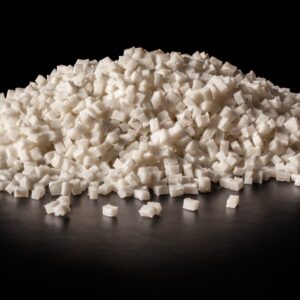Description
Polyethylene (PE)
General Information
The most abundant commodity plastic is Polyethylene (PE), which finds extensive application in the packaging industry. Polyolefins include polyethylene. Bags for frozen goods and foods, various bottles, cereal liners, containers of yogurt, and more. frequently have this lightweight yet sturdy plastic. Polyethylene, which makes everything you see around you, has a recycling code of 2 or 4. Crystalline structures in PE polymers vary.
Usage of Polyethylene (PE)
Polyethylene (PE), also known as HDPE, LDPE, and LLDPE, is the most widely produced plastic in the world. So, where do you usually find PE being used? In addition to the many uses already mentioned, polyethylene is also helpful for various other things, such as electrical insulation, household containers, packaging, films, and even buckets and bottles. No one can deny that polyethylene is an excellent material for use in various contexts due to its exceptional mix of qualities. In addition, it can be designed to meet the needs of its final application. There is a wide variety of uses for polyethylene , which is available in more than 6800 different grades:
- HDPE is usually used in the production of crates, trays, bottle caps, drums, etc., all of which are utilized in packaging bottles and films. Films, plastic bags, trash bags, and other forms of food packaging are LDPE’s primary applications.
- Patches, PPE, packing films, containers, livestock, bag headers, etc., are all examples of medical and healthcare items that benefit from this material.
- PE parts that are used in gas pipes, water pipes, sewer pipes, hoses, etc. are very resistant to chemicals and water.
- Products for the home include trash cans, pots, pans, bowls, ice buckets, ketchup bottles, and more.
- In the agricultural industry, PE films are commonly used for mulching, covering greenhouses, walk-in tunnels, and low tunnels.
- Insulate and jacket your wiring with a crosslinked polyethylene or polyethylene copolymer resin.
Technical data sheet & Chemical Formula
Technical datasheet
With two single bonds to its carbon neighbors on either side, the carbon backbone forms the primary Polyethylene polymer. The hydrogen atoms occupy the last two binding sites on the carbon. The (C2H4)n formula for polyethylene represents the number of times an ethylene molecule has been repeated to create the polymer.

Packing of Polyethylene (PE)


Packing of Polyethylene
Polyethylene is widely available in several forms, including bags, grains, etc. Polyethylene packaging can appear milky-opaque, opaque, or translucent depending on its thermal history and film thickness. By blocking out light, PE helps prevent UV rays from damaging the contents of the package. To better showcase the contents, polypropylene bags are made to be highly transparent. The PP bag effectively blocks air and moisture, making it ideal for storing perishable goods. The poly bags put a halt to the loss of moisture and freshness that occurs during the drying and storage processes that accompany conventional packaging. In comparison to their PE plastic counterparts, PP plastics are typically more expensive, more durable, and clearer. Polypropylene bags have many uses outside of the food industry, including those in the electronics and electronics manufacturing sectors, healthcare settings, the agricultural sector, and more.
Safety & warning & transportation
PE, when in solid form, is commonly utilized in the food industry. Inhaling the fumes or getting the liquid on your skin or eyes (i.e., during manufacturing processes) could be harmful. Carefully observe all safety precautions and handling guidelines when working with molten polymers. Several safety groups, notably the IARC, known as the International Agency for Research on Cancer, and the OSHA, known as the Occupational Safety and Health Administration, have concluded that polyethylene is not carcinogenic, as stated in the material’s Safety Data Sheet (OSHA). So, generally, it’s usually safe, but if you choose an untrusted and cheap manufacturer, then you will get hazardous and bad-quality PE.






Reviews
There are no reviews yet.